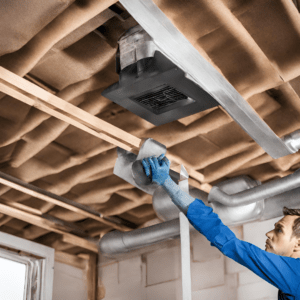Insulating Your HVAC System: Key Tips for Winter Efficiency
 As winter approaches, keeping your home warm and comfortable becomes a top priority.
As winter approaches, keeping your home warm and comfortable becomes a top priority.
A well-functioning HVAC system alone isn’t sufficient; you need to ensure it operates efficiently to avoid skyrocketing energy bills and unnecessary wear and tear on your equipment.
That’s where insulation comes into play and is a crucial step in achieving winter efficiency, as it helps trap heat, minimizes energy wastage, and ensures a toasty home without burning a hole in your pocket.
Exploring the ins and outs of insulating your HVAC system can help keep your home warm and energy-efficient throughout the winter season.
Understanding HVAC Insulation
HVAC insulation involves the installation of insulating materials within your HVAC system’s components to reduce heat transfer, ensuring temperature consistency and enhancing energy efficiency.
This insulation is vital for maintaining warm air warmth and cold air coolness, crucial for a well-controlled indoor environment, especially during the winter.
Proper insulation can reduce your system’s workload, leading to lower energy costs and creating a more comfortable and budget-friendly living space.
Common Problem Areas
Insulation alone isn’t enough – sealing gaps and leaks is equally vital.
- Ductwork: Uninsulated or leaky ducts can waste a significant amount of heated air, reducing system efficiency.
- Attics and Crawl Spaces: These areas are prime sources of heat loss if not properly insulated.
- Walls and Windows: Inadequate insulation in walls and around windows can lead to drafts and energy loss.
Proper insulation alone is not enough; sealing gaps and leaks is equally crucial for maintaining winter efficiency.
- Gaps and leaks can allow cold air to infiltrate and warm air to escape, making your system work harder.
- Sealing these openings prevents energy waste, reduces drafts, and ensures a consistent indoor temperature.
- Insulation improves indoor air quality by preventing dust and pollutants from entering through gaps in the insulation.
- Properly insulated and sealed areas result in lower energy bills and a more comfortable home, making your winter season much more efficient and pleasant.
Insulation Materials
When it comes to insulating your HVAC system, you have several materials to choose from. Each type of insulation material has its own set of advantages and drawbacks.
Here’s a quick breakdown of some common options:
Fiberglass Insulation
Pros
- Widely available and affordable
- Effective at reducing heat transfer
- Resistant to mold and moisture
Cons
- Can be irritating to the skin and respiratory system during installation.
- Must be handled with care to avoid skin contact or inhalation.
Foam Board Insulation
Pros
- High insulation value, meaning it’s effective in reducing heat transfer
- Lightweight and easy to work with
Cons
- More expensive compared to fiberglass
- Vulnerable to damage from moisture unless properly sealed
Reflective Foil Insulation
Pros
- Excellent for reflecting radiant heat
- Doesn’t degrade over time
Cons
- Less effective in colder climates where conductive heat transfer is more prominent
- More expensive compared to some other materials
Each material has its own strengths and weaknesses, so it’s essential to select the one that best suits your requirements for winter efficiency.
Conclusion
The key to a warm, energy-efficient winter lies in the careful selection and installation of insulation materials. Properly insulating your HVAC system is the cornerstone of winter efficiency, allowing you to trap heat, reduce energy waste, and keep your home snug without straining your budget.
Understanding the various insulation materials, from cost-effective fiberglass to high-value foam board and reflective foil, empowers you to make informed decisions. But remember, insulation alone is not the whole solution. Identifying and sealing those pesky gaps and leaks in ducts, attics, crawl spaces, walls, and windows is equally vital.
Sealing these openings serves to further reduce energy waste, combat drafts, and maintain a consistent indoor temperature. It also contributes to improved indoor air quality, keeping out dust and pollutants.
The culmination of proper insulation and sealing results in lower energy bills and a home that’s both comfortable and budget-friendly, making your winter season far more efficient and enjoyable.

 Jacobs and Rhodes
Jacobs and Rhodes Jacobs and Rhodes
Jacobs and Rhodes